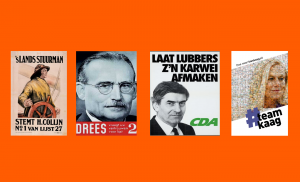
The guy or the tent, the woman or the building
Another five months or so and the next House of Representatives elections will take place. Preparations for this have been in full swing for some time now; There doesn't seem to be much change in some parties; well-known names who will once again take the lead and some substantive shifts in emphasis.
A striking development is taking place at D66. The NRC recently devoted almost an entire page to their campaign (#TeamKaag) and called the campaign 'un-Dutch'. The party's name hardly appears in the campaign; it is mainly about Sigrid Kaag. An interesting new form: attention is mainly generated for the party leader and the substantive direction of the party fades into the background.
But is that really so un-Dutch? A little dive into parliamentary history offers interesting insights. Campaigns and also election posters in which the leader plays a prominent role have proven to be more successful in the past than those in which the content was central. Before the Second World War, it was a campaign with Hendrik Colijn in the leading role that ensured that he remained firmly in the saddle. And after the war, more or less the same applied to Willem Drees. Election posters from those years even lack the name of the party. And a little fresher in our memories is the CDA campaign in the 1980s in which voters were asked to let Ruud Lubbers – not the CDA – finish his job.
Yet there is a catch. So far, focusing on the party leader has only proven successful if he has been given the status of a statesman (unfortunately we do not have a stateswoman yet). That was the case with Colijn, Drees and Lubbers. There are also plenty of examples showing that solely or mainly depicting a party leader who has made his or her mark less prominently does not work. Consider, for example, the SP's campaign with Roemer in 2012, where the SP thought they could make Roemer prime minister. That failed and then their campaign collapsed shortly afterwards.
A double campaign such as D66 has announced seems new and is interesting to follow. Such a campaign will undoubtedly generate extra attention for the party leader and offers plenty of opportunities to use new communication techniques and channels. And this will probably make it easier to mobilize non-members – and especially young people. However, it also has a risk: it can also become a 'Roemertje'. It remains important that there is the right balance between attention for the party leader and for the content of the party: in an ideal situation they reinforce each other. For D66, it remains extremely important to guard against a situation in which the guy becomes bigger than the tent: in this case, the woman becomes bigger than the building.


